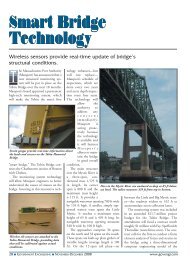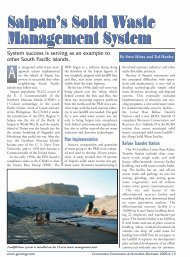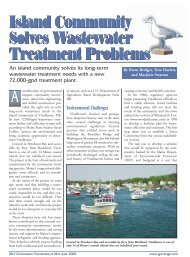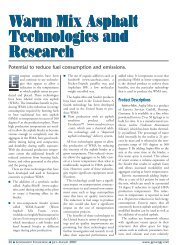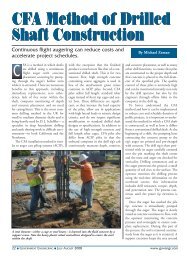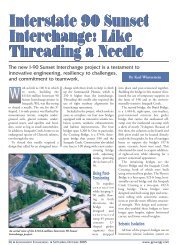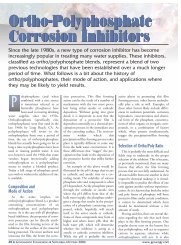Jacking Pipe in Phoenix Soils - Government Engineering Journal
Jacking Pipe in Phoenix Soils - Government Engineering Journal
Jacking Pipe in Phoenix Soils - Government Engineering Journal
Create successful ePaper yourself
Turn your PDF publications into a flip-book with our unique Google optimized e-Paper software.
<strong>Jack<strong>in</strong>g</strong> <strong>Pipe</strong> <strong>in</strong><br />
<strong>Phoenix</strong> <strong>Soils</strong><br />
Project is a first <strong>in</strong> the most significant upsize and maximum<br />
drive length <strong>in</strong> the United States us<strong>in</strong>g the static pull<br />
burst<strong>in</strong>g method with replacement segmental pipe.<br />
By Robert Webb and<br />
Roger Olsen<br />
P<br />
hoenix has been experienc<strong>in</strong>g<br />
tremendous population growth<br />
<strong>in</strong> recent years, as part of the<br />
grow<strong>in</strong>g Southwest region of the<br />
United States. This growth has taxed<br />
some areas of its collection system.<br />
Through recent sewer model<strong>in</strong>g updates<br />
and the new Arizona Department of<br />
Environmental Quality design requirements,<br />
portions of the city’s wastewater<br />
collection system were found to be at,<br />
above, or near<strong>in</strong>g capacity. The addition<br />
of the new <strong>in</strong>filtration and <strong>in</strong>flow design<br />
requirements, coupled with the recent<br />
population growth and the recent calibration<br />
of its sewer model, <strong>in</strong>dicated the<br />
city’s collection system would require<br />
immediate upgrades <strong>in</strong> many locations.<br />
<strong>Phoenix</strong> developed the Sanitary<br />
Sewer Relief and Replacement Program<br />
to confront these issues. The potential<br />
capacity deficiencies could impact new<br />
Peoria Avenue <strong>Pipe</strong> Burst—15-<strong>in</strong>. to 18-<strong>in</strong>. vitrified clay pipe.<br />
development upstream, which is an<br />
important stimulus to the <strong>Phoenix</strong><br />
economy. Upsiz<strong>in</strong>g with full pipe<br />
replacement, relief sewers, diversions,<br />
and other techniques were considered as<br />
solutions to this potential capacity deficiency.<br />
The use of trenchless technologies<br />
was approved by <strong>Phoenix</strong> as an<br />
acceptable alternative approach to m<strong>in</strong>imize<br />
the impacts created by these construction<br />
projects.<br />
<strong>Phoenix</strong> decided to use a<br />
Construction Manager at Risk<br />
(CM@R) delivery method to tackle this<br />
enormous undertak<strong>in</strong>g. Project<br />
Eng<strong>in</strong>eer<strong>in</strong>g Consultants (PEC,<br />
www.pecaz.com) was one of eight eng<strong>in</strong>eer<strong>in</strong>g<br />
firms selected for this program.<br />
In particular, PEC was assigned a relief<br />
sewer project <strong>in</strong> the area of 35th Avenue<br />
and Peoria Avenue <strong>in</strong> <strong>Phoenix</strong>. PEC<br />
worked closely with Kiewit Western<br />
Company (CM@R contractor) from the<br />
30 percent phase of the design to develop<br />
an <strong>in</strong>novative approach to <strong>in</strong>crease<br />
the capacity deficiencies with m<strong>in</strong>imal<br />
socio-economic impact. The goal was to<br />
consider alternatives that would m<strong>in</strong>imize<br />
conventional open-cut construction<br />
headaches such as imped<strong>in</strong>g traffic,<br />
impact<strong>in</strong>g local bus<strong>in</strong>ess and customers<br />
and to ultimately render a less costly<br />
solution. <strong>Pipe</strong> burst<strong>in</strong>g was determ<strong>in</strong>ed<br />
to fulfill the need for upsiz<strong>in</strong>g these<br />
capacity deficient pipes without open<br />
trench<strong>in</strong>g their streets. Kiewit submitted<br />
a f<strong>in</strong>al guaranteed maximum price of<br />
$5.3 million for pipe burst<strong>in</strong>g, which<br />
fell well below the open-cut cost model<br />
for the project—about $7.9 million.<br />
Project Details<br />
The project consisted of an unprecedented<br />
upsiz<strong>in</strong>g of nearly 7,400 ft of<br />
exist<strong>in</strong>g 12- and 15-<strong>in</strong>. pipe, which are<br />
ten to 20 ft deep under major streets<br />
with the usual multitude of exist<strong>in</strong>g utilities.<br />
The sewer layout consisted of two<br />
ma<strong>in</strong> l<strong>in</strong>es perpendicular to each other<br />
that <strong>in</strong>tersected at Peoria Avenue and<br />
35th Avenue. The 2,500 ft along Peoria<br />
sewer ma<strong>in</strong> was an exist<strong>in</strong>g 15-<strong>in</strong>. vitrified<br />
clay pipe (VCP) to be upsized to<br />
18-<strong>in</strong>. diameter. The 4,700 ft along<br />
35th Avenue sewer ma<strong>in</strong> was for the<br />
most part an exist<strong>in</strong>g 12-<strong>in</strong>. VCP pipe<br />
to be double upsized for most of its<br />
length to an 18-<strong>in</strong>. diameter. The<br />
method of pipe burst selected was static<br />
pull with “cartridge” load<strong>in</strong>g us<strong>in</strong>g segmented<br />
jack<strong>in</strong>g pipe.<br />
This method of pipe burst<strong>in</strong>g kept<br />
the jobsite footpr<strong>in</strong>t relatively small and<br />
compact. Utiliz<strong>in</strong>g segmented pipe<br />
elim<strong>in</strong>ates the need for a long lay-down<br />
26 ■ GOVERNMENT ENGINEERING ■ NOVEMBER-DECEMBER 2009 www.govengr.com
Grundoburst 2500G (top) and extraction<br />
cage (bottom) <strong>in</strong> receiv<strong>in</strong>g pit.<br />
area on the project site as would be<br />
required with welded pipe. This is highly<br />
beneficial <strong>in</strong> high-traffic urban sett<strong>in</strong>gs<br />
as long str<strong>in</strong>gs of welded pipe<br />
would have <strong>in</strong>hibited traffic flow and<br />
driveway access before and dur<strong>in</strong>g the<br />
burst<strong>in</strong>g operation. Consequently, traffic<br />
control did not become a major issue<br />
for this project dur<strong>in</strong>g the pipe burst<strong>in</strong>g<br />
operation.<br />
Launch and receiv<strong>in</strong>g pits were constructed<br />
at new manhole locations at<br />
about 400-ft <strong>in</strong>tervals. Trench boxes<br />
were used to stabilize the walls of the<br />
pits and provide a safe work<strong>in</strong>g environment<br />
allow<strong>in</strong>g ample room for equipment<br />
and pipe. The burst<strong>in</strong>g equipment<br />
could easily be rotated 180-degrees <strong>in</strong><br />
the launch<strong>in</strong>g pit to beg<strong>in</strong> burst<strong>in</strong>g pipe<br />
from the opposite direction.<br />
<strong>Pipe</strong> burst<strong>in</strong>g requires the flow <strong>in</strong> the<br />
exist<strong>in</strong>g pipe to be bypassed or diverted<br />
out of the pipe. The exist<strong>in</strong>g pipe was<br />
cleaned and closed-circuit television<br />
<strong>in</strong>spected to ensure there were no severe<br />
alignment problems, sags, and to locate<br />
all service laterals before <strong>in</strong>stallation of<br />
new pipe. Exist<strong>in</strong>g service laterals were<br />
<strong>in</strong>tercepted, monitored dur<strong>in</strong>g the operation,<br />
and connected <strong>in</strong>to the sewer<br />
bypass system, which ran above and<br />
alongside the pipe burst<strong>in</strong>g operation.<br />
The bypass pip<strong>in</strong>g was conveniently tied<br />
to the sewer system far downstream<br />
from all the operations. When a driveway<br />
was encountered, the bypass pip<strong>in</strong>g<br />
was trenched under and paved to allow<br />
property owners full access at all times.<br />
The project also <strong>in</strong>cluded a 200-ft<br />
jack-and-bore portion through the high<br />
traffic volume <strong>in</strong>tersection of 35th<br />
Avenue and Peoria Avenue. The CM@R<br />
used a local subcontractor to perform<br />
that operation. It entailed a setup that<br />
<strong>in</strong>stalled a 36-<strong>in</strong>. OD, 3/8-<strong>in</strong>. thick steel<br />
cas<strong>in</strong>g diagonally across the <strong>in</strong>tersection<br />
from the traffic island <strong>in</strong> Peoria Avenue<br />
northeast to the sidewalk <strong>in</strong> 35th<br />
Avenue. 180 l<strong>in</strong>ear ft of 18-<strong>in</strong>. bell-andspigot<br />
VCP was jacked <strong>in</strong>to the new cas<strong>in</strong>g.<br />
The jack-and-bore took about 3.5<br />
weeks to complete. An additional two to<br />
three days was added to the jack-andbore<br />
schedule because part of the tunnel<br />
had to be hand m<strong>in</strong>ed.<br />
All the utilities <strong>in</strong> the pipe zone were<br />
identified <strong>in</strong> the plans and marked by<br />
the respective Arizona Call Center “Blue<br />
Stake.” Some of these <strong>in</strong>cluded fiber<br />
optics conduits and electric duct banks,<br />
which were potholed and surveyed,<br />
waterl<strong>in</strong>es, telephone conduits, natural<br />
gas l<strong>in</strong>es, storm dra<strong>in</strong> connectors, and<br />
sewer l<strong>in</strong>es. Dur<strong>in</strong>g <strong>in</strong>itial construction<br />
<strong>in</strong> one portion of the alignment, problems<br />
were encountered with an exist<strong>in</strong>g<br />
40-year old six-<strong>in</strong>. water ma<strong>in</strong> composed<br />
of asbestos cement pipe (ACP),<br />
which meandered adjacent to the sewer<br />
alignment. The ACP water ma<strong>in</strong> began<br />
break<strong>in</strong>g at multiple locations apparently<br />
due to pipe movement caused from<br />
soil displacement dur<strong>in</strong>g the pipe burst<strong>in</strong>g<br />
operation. The city decided to relocate<br />
the entire portion of the ACP<br />
waterl<strong>in</strong>e, which was with<strong>in</strong> six ft of the<br />
exist<strong>in</strong>g sewer pipe.<br />
The decision to relocate<br />
this exist<strong>in</strong>g<br />
water l<strong>in</strong>e would have<br />
been the same if an<br />
open-cut construction<br />
method was<br />
elected over pipe<br />
burst<strong>in</strong>g. There were<br />
no other major conflicts<br />
with utilities<br />
and no service disruptions<br />
dur<strong>in</strong>g construction.<br />
The utilities<br />
that ended up <strong>in</strong><br />
the pit areas were<br />
supported and ma<strong>in</strong>ta<strong>in</strong>ed<br />
at all times.<br />
Pothol<strong>in</strong>g of electrical utilities was<br />
performed dur<strong>in</strong>g design. In addition to<br />
pothol<strong>in</strong>g, soil bor<strong>in</strong>gs were collected<br />
every 150 to 200 ft along the project for<br />
a total of 19 soil bor<strong>in</strong>gs. Soil bor<strong>in</strong>g<br />
data is important for pipe burst<strong>in</strong>g and<br />
jack-and-bore projects to determ<strong>in</strong>e feasibility.<br />
Soil classification, size, and density<br />
are particularly important.<br />
Burst<strong>in</strong>g Challenges<br />
Generally, the pipe burst<strong>in</strong>g went<br />
smoothly, which was commendable, due<br />
to conditions that had to be overcome.<br />
The Peoria Avenue section had the most<br />
challenges due to the orig<strong>in</strong>al pipe<br />
<strong>in</strong>stallation and exist<strong>in</strong>g trench configurations.<br />
There were three locations along<br />
Peoria Avenue that required excavation.<br />
The equipment operator could usually<br />
determ<strong>in</strong>e when harder conditions were<br />
encountered by the sound of the burst<strong>in</strong>g<br />
unit’s power pack. Excessive<br />
hydraulic pressures usually <strong>in</strong>dicated the<br />
presence of an obstruction. It was more<br />
economical for the contractor to cont<strong>in</strong>ue<br />
the pipe burst and avoid open-cut<br />
due to higher production rates with pipe<br />
burst<strong>in</strong>g. One obstruction proved to be<br />
non-compressible backfill (cementitious<br />
cap) or an exist<strong>in</strong>g po<strong>in</strong>t repair. The<br />
cementitious cap appeared to be low<br />
strength because the burst<strong>in</strong>g operation<br />
pulled through much of it. When difficult<br />
ground conditions caused hydraulic<br />
pressures to exceed the work<strong>in</strong>g limits of<br />
the mach<strong>in</strong>e, it was mutually decided to<br />
open-cut those portions. The burst<strong>in</strong>g<br />
head was excavated and a portion was<br />
24-<strong>in</strong>. OD expander followed by the new 18-<strong>in</strong>. VCP jack<strong>in</strong>g<br />
pipe on arrival <strong>in</strong>to the receiv<strong>in</strong>g pit.<br />
www.govengr.com GOVERNMENT ENGINEERING ■ NOVEMBER-DECEMBER 2009 ■ 27
hand laid for a short distance until the<br />
ground conditions improved allow<strong>in</strong>g<br />
burst<strong>in</strong>g operations to resume.<br />
In isolated cases, the orig<strong>in</strong>al pipe was<br />
laid closer to one side of the orig<strong>in</strong>al<br />
trench wall and not the centerl<strong>in</strong>e of the<br />
trench. The orig<strong>in</strong>al trench wall was<br />
more unyield<strong>in</strong>g than the bedd<strong>in</strong>g and<br />
backfill materials and would not accept<br />
the necessary compaction required by<br />
the pipe burst<strong>in</strong>g process as readily as<br />
the bedd<strong>in</strong>g and backfill material. These<br />
obstacles <strong>in</strong>creased pull<strong>in</strong>g tensions<br />
above the equipment’s safe work<strong>in</strong>g limits.<br />
In these situations, the burst<strong>in</strong>g head<br />
was excavated and pipe was hand laid<br />
until conditions improved. If additional<br />
<strong>in</strong>formation about the trench geometry,<br />
pipe location, and other obstructions<br />
would have been available, shafts might<br />
have been relocated result<strong>in</strong>g <strong>in</strong> a different<br />
pipe burst<strong>in</strong>g strategy.<br />
40-ton cyl<strong>in</strong>der pack.<br />
The contractor’s second pull at 35th<br />
Avenue exceeded all expectations. After<br />
the first pull of about 98 ft, the mach<strong>in</strong>e<br />
was relocated downstream and the<br />
longest burst of 448 ft was accomplished<br />
with only m<strong>in</strong>or issues. There were<br />
some areas where m<strong>in</strong>or heav<strong>in</strong>g was<br />
observed because the exist<strong>in</strong>g bottom of<br />
the pipe was about ten ft deep. M<strong>in</strong>or<br />
cracks occurred <strong>in</strong> paved areas where the<br />
access streets were to be repaired anyway.<br />
A portion of sidewalk rose around<br />
a bus bay, which was easily repaired.<br />
Other than these few locations, no other<br />
locations of heave were observed.<br />
A portion of the upstream pipe rose a<br />
few <strong>in</strong>ches dur<strong>in</strong>g the <strong>in</strong>itial pull back<br />
and the contractor adjusted those few<br />
pipe sections before re<strong>in</strong>stall<strong>in</strong>g a new<br />
manhole <strong>in</strong> the launch<strong>in</strong>g pit. This was<br />
the longest attempt us<strong>in</strong>g this method<br />
of pipe burst<strong>in</strong>g, which was an encourag<strong>in</strong>g<br />
turn for the project and helped<br />
calm some of the jitters. The pull back<br />
was completed <strong>in</strong> only a few hours.<br />
Initially, the project schedule was<br />
delayed due to record summer ra<strong>in</strong>falls<br />
dur<strong>in</strong>g the “monsoon” season <strong>in</strong> the valley.<br />
Ra<strong>in</strong> also delayed the project for two<br />
to three days dur<strong>in</strong>g the w<strong>in</strong>ter ra<strong>in</strong>y<br />
season <strong>in</strong> December. Ra<strong>in</strong> delays were<br />
ma<strong>in</strong>ly due to pit flood<strong>in</strong>g.<br />
Burst<strong>in</strong>g Equipment Setup<br />
The static pipe burst<strong>in</strong>g equipment,<br />
provided by TT Technologies Inc.<br />
(www.tttechnologies.com), <strong>in</strong>cluded a<br />
Grundoburst® 2500G static burst<strong>in</strong>g<br />
mach<strong>in</strong>e and the accompany<strong>in</strong>g tool<strong>in</strong>g.<br />
This mach<strong>in</strong>e can pull up to 315 tons. It<br />
would prove necessary to use virtually<br />
all of the mach<strong>in</strong>e’s capacity <strong>in</strong> the difficult<br />
soil conditions encountered on the<br />
project. The Grundoburst 2500G<br />
mach<strong>in</strong>e utilizes Quicklock rods<br />
between the mach<strong>in</strong>e and the expander<br />
that weigh about 400 lb each. These<br />
rods were connected to a special 22-<strong>in</strong>.<br />
OD expander sized for the new 18-<strong>in</strong>.<br />
VCP. The expander had a special <strong>in</strong>ternal<br />
socket arrangement for the lead<br />
piece of VCP to butt aga<strong>in</strong>st. To add<br />
new sections of pipe as the pull progressed,<br />
additional rods were added followed<br />
by the pipe sections, which were<br />
slipped over the rods. The cyl<strong>in</strong>der pack<br />
with three pressure plates was then<br />
employed and p<strong>in</strong>ned to the rods. Next,<br />
the plate was hydraulically energized to<br />
serve two functions: 1) push the newly<br />
added pipe jo<strong>in</strong>t fully “home,” and 2)<br />
hold the entire jack<strong>in</strong>g pipe tra<strong>in</strong> <strong>in</strong><br />
compression as the pipe burst<strong>in</strong>g<br />
expander was pulled forward.<br />
The burst<strong>in</strong>g equipment for this project<br />
was designed and assembled for the<br />
specific purpose of burst<strong>in</strong>g the exist<strong>in</strong>g<br />
VCP and tow<strong>in</strong>g <strong>in</strong> the new nonrestra<strong>in</strong>ed<br />
jo<strong>in</strong>t jack<strong>in</strong>g VCP. A ride<br />
along hydrostatic mach<strong>in</strong>e attached to<br />
burst<strong>in</strong>g rods <strong>in</strong>side the new pipe sections<br />
kept the column of assembled pipe<br />
segments <strong>in</strong> compression as the burst<strong>in</strong>g<br />
progressed. The pipe sections were lowered<br />
<strong>in</strong>to the pit and the pipe jo<strong>in</strong>ts were<br />
pushed home with the cyl<strong>in</strong>der pack via<br />
a pressure plate. The cyl<strong>in</strong>der pack provided<br />
40 tons of force to keep the assembled<br />
pipe segments <strong>in</strong> compression (and<br />
28 ■ GOVERNMENT ENGINEERING ■ NOVEMBER-DECEMBER 2009 www.govengr.com
ods <strong>in</strong> tension) as the burst<strong>in</strong>g head is<br />
pulled toward the Grundoburst static<br />
pipe burst<strong>in</strong>g mach<strong>in</strong>e. The cyl<strong>in</strong>der<br />
pack was sized accord<strong>in</strong>g to the pipe<br />
manufacturers’ specification for the<br />
weight of each 18-<strong>in</strong>. diameter pipe section.<br />
For example, <strong>in</strong> a 400-l<strong>in</strong>ear ft (lf)<br />
run: 133 lb/lf x 400 lf=53,200 lb 27<br />
tons), which is well with<strong>in</strong> the limits of<br />
the cyl<strong>in</strong>der pack’s 40-ton capacity. As<br />
the burst<strong>in</strong>g head is pulled forward fractur<strong>in</strong>g<br />
the exist<strong>in</strong>g VCP and expand<strong>in</strong>g<br />
the fragments <strong>in</strong>to the surround<strong>in</strong>g<br />
backfill, the rear cyl<strong>in</strong>der pack pressure<br />
plate keeps the assembled pipe sections<br />
<strong>in</strong> compression.<br />
The contractor’s team kept <strong>in</strong> constant<br />
telephone/radio communication<br />
and the hydrostatic pressures were<br />
observed and recorded real-time dur<strong>in</strong>g<br />
the burst<strong>in</strong>g operation. To absorb these<br />
pressures, a chipboard compression r<strong>in</strong>g<br />
was <strong>in</strong>stalled between each pipe jo<strong>in</strong>t to<br />
distribute the axial load transferred from<br />
one pipe section to another. Cycle times<br />
for each section of pipe to be assembled<br />
and pulled forward dur<strong>in</strong>g burst<strong>in</strong>g<br />
began at an average rate of 1/2 ft per<br />
m<strong>in</strong>ute. As the project progressed, the<br />
crew became much more efficient<br />
result<strong>in</strong>g <strong>in</strong> average rate of one ft per<br />
m<strong>in</strong>ute. Thus, a typical 350-ft reach was<br />
completed <strong>in</strong> 5 1/2 to six hours.<br />
Product <strong>Pipe</strong><br />
NO-DIG® vitrified clay jack<strong>in</strong>g pipe<br />
(Mission Clay Products, www.missionclay.com)<br />
was used as the replacement<br />
pipe material on the project. This gravity<br />
flow sewer pipe has been used for<br />
slurry microtunnel<strong>in</strong>g (MTBM), pilot<br />
tube microtunnel<strong>in</strong>g (GBM), slipl<strong>in</strong><strong>in</strong>g<br />
steel cas<strong>in</strong>g, and now static pull pipe<br />
burst<strong>in</strong>g. The vitrification process produces<br />
a material with average compressive<br />
strength of 18,000 psi. The jack<strong>in</strong>g<br />
pipes are manufactured with a precision<br />
ground jo<strong>in</strong>t; a Polyisoprene, EPDM, or<br />
Nitrile elastomer compression gasket;<br />
and a Series 316 sta<strong>in</strong>less steel collar at<br />
each pipe jo<strong>in</strong>t.<br />
The standard 6 1/2-ft length of 18-<strong>in</strong>.<br />
NO-DIG pipe utilizes a s<strong>in</strong>gle f<strong>in</strong> elastomer<br />
compression gasket with 4 3/4-<strong>in</strong>.<br />
wide, 16-gauge, 0.06-<strong>in</strong>. thick sta<strong>in</strong>less<br />
steel collars at each jo<strong>in</strong>t. It was decided<br />
on this project, due to the stra<strong>in</strong> on the<br />
The first pipe section on each burst<strong>in</strong>g run was fitted with a lubricant port and a<br />
“Witches Hat” check valve (<strong>in</strong>set) to reduce frictional pull<strong>in</strong>g forces.<br />
pipe jo<strong>in</strong>t dur<strong>in</strong>g the <strong>in</strong>stallation<br />
process, to use a double f<strong>in</strong> elastomer<br />
gasket with a five-<strong>in</strong>. wide, 13-gauge,<br />
0.09-<strong>in</strong>. sta<strong>in</strong>less steel collar. This double<br />
f<strong>in</strong>ned jo<strong>in</strong>t with the heavier steel<br />
collar is the standard <strong>in</strong> pipe diameters<br />
24-<strong>in</strong>. and up.<br />
The first pipe section on each burst<strong>in</strong>g<br />
run, a three-ft sacrificial piece<br />
beh<strong>in</strong>d the expander, was fitted with a<br />
lubricant port to reduce frictional<br />
pull<strong>in</strong>g forces (pipe drag). This three-ft<br />
section placed the first “pivot<strong>in</strong>g and<br />
flexible” jo<strong>in</strong>t just outside the rear of the<br />
expander to allow movement as opposed<br />
to hav<strong>in</strong>g a full 6 1/2-ft pipe section. To<br />
manufacture the lube port the factory<br />
cored a 2 1/4-<strong>in</strong>. hole <strong>in</strong> the pipe barrel<br />
for a 1 1/2-<strong>in</strong>. National <strong>Pipe</strong> Thread<br />
(NPT) threaded coupl<strong>in</strong>g, attached<br />
us<strong>in</strong>g ceramic epoxy, to accept a 1 1/2-<br />
<strong>in</strong>. NPT “Witches Hat”" one way check<br />
valve. Microtunnel<strong>in</strong>g Inc. (www.microtunnel<strong>in</strong>g.com)<br />
supplied these check<br />
valves for the project.<br />
Conclusion<br />
Production rates were affected by<br />
unknown conditions such as a cementitious<br />
cap, dry dense soil conditions adjacent<br />
to the exist<strong>in</strong>g trench, and the<br />
exist<strong>in</strong>g sewer pipe alignments. Another<br />
production delay orig<strong>in</strong>ated when the<br />
contractor opted to open-cut <strong>in</strong> lieu of<br />
pipe bust<strong>in</strong>g at one location. On the<br />
other hand, at two locations, open-cut<br />
was specified on the plans to correct<br />
reverse slopes and the contractor<br />
obta<strong>in</strong>ed approval to pipe burst at these<br />
locations. Not all of the construction<br />
delays can be attributed to this lack of<br />
<strong>in</strong>formation. However, if more <strong>in</strong>formation<br />
about the orig<strong>in</strong>al trench geometry<br />
were known ahead of construction,<br />
unexpected delays <strong>in</strong> production could<br />
have been m<strong>in</strong>imized.<br />
<strong>Pipe</strong> production via pipe burst<strong>in</strong>g<br />
exceeded everyone’s expectations. The<br />
project took n<strong>in</strong>e months to complete<br />
the pipe burst<strong>in</strong>g and jack-and-bore<br />
activities. The contractor estimated that<br />
the project would have taken at least 12<br />
months to complete if it had been opencut.<br />
In addition to the construction<br />
duration sav<strong>in</strong>gs, the project accomplished<br />
a maximum drive length of 448<br />
ft. This is the longest length of jack<strong>in</strong>g<br />
VCP to be <strong>in</strong>stalled via pipe burst<strong>in</strong>g <strong>in</strong><br />
the United States. In addition, the project<br />
was the first <strong>in</strong> the United States to<br />
perform a double upsize pipe burst<br />
us<strong>in</strong>g jack<strong>in</strong>g VCP.<br />
GE<br />
Mr. Webb is Water and Wastewater Director,<br />
Project Eng<strong>in</strong>eer<strong>in</strong>g Consultants, Ltd. Mr.<br />
Olsen is Construction Manager, City of<br />
<strong>Phoenix</strong>, Water Services Department,<br />
<strong>Phoenix</strong>, AZ.<br />
www.govengr.com GOVERNMENT ENGINEERING ■ NOVEMBER-DECEMBER 2009 ■ 29



